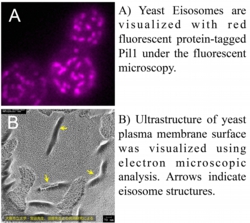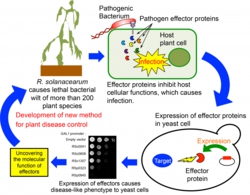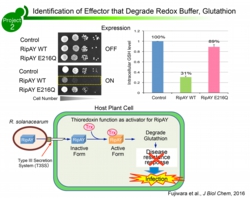
Plasma Membrane Stress Response in Yeast
Plasma membrane is constitutively damaged from various physical stresses such as heat stress, osmotic stress, membrane tension, which causes plasma membrane stresses. For example, in humans, myocytes are constantly damaged by exposure to physical membrane stress by repeating expansion and contraction as they move intensely. However, cells have a mechanism to repair such damage. In animal cells, it is known that a structure called “caveolae” plays an essential role in repairing membrane damage, and caveolae abnormality is known to be a cause of cardiomyopaty.
Yeast is a unicellular eukaryote and has contributed to the elucidation of various intracellular mechanisms such as cell cycle, vesicular trafficking, signal transductions and autophagy as a model eukaryotic cell. Mechanisms for sensing and repairing membrane stress are also present in yeast cells, and “eisosome” are known as organelles corresponding to caveolae of animal cells. Our laboratory focus on cellular function of eisosome and is interested in the downstream signaling pathway (sphingolipid metabolism, actin cytoskeleton reorganization) that activates the membrane repair during plasma membrane stresses.
1. Tabuchi et al., Mol Cell BIol, 15: 5861-75, 2006.
2. Audhya et al., EMBO J, 23: 3737-57, 2004.
Functional Analysis of the Plant Pathogen Effectors by Yeast
Numerous bacterial pathogens of plants and animals inject virulence proteins, so-called “effetors", directory into the host cell cytoplasm through specialized secretion apparatuses, such as the type III secretion system (T3SS). The translocated effector proteins manipulate diverse host cellular processes to promote the perturbation of host immune system and ultimately cause infection.
In our laboratory, we are conducting yeast system to uncover the molecular function of effectors from Ralstonia solanacarum, which is the most destructive bacterial pathogen in plant. If the effector inhibits the yeast counterpart of the host effector target and then give us a phenotype, such as growth inhibition of yeast. This effector-induced growth inhibition allows us to understand the molecular function of effectors.
Recently, by using the yeast system, we found one of the R. solanacearum effector, RipAY functions as a glutathione degradation enzyme to inhibit host immune response (1, 2).
1. Popa C., Tabuchi M. and Valls M, Front. Cell. Infect. Microbiol., 6, 73, 2016.
2. Fujiwara S., Kawazoe T., Ohnishi K., Kitagawa T., Popa C., Valls M., Genin S., Nakamura K., Kuramitsu Y., Tanaka N. and Tabuchi M, J. Biol. Chem., 291 (13), 6813-6830, 2016.
3. Tabuchi M., Kawai Y., Nishie-Fujita M., Akada R., Izumi T., Yanatori I., Miyashita N., Ouchi K. and Kishi F, Biosci Biotech, and Biochem, 73, 2261-7, 2009.
 HOME
HOME




 Forward
Forward